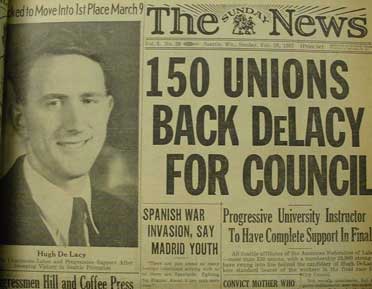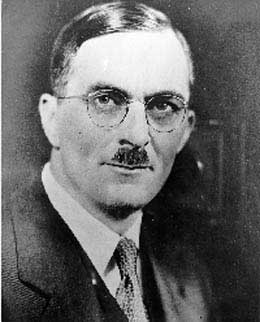What Are the Three Government Institutions the Reading States Fdr Created?
Politics

The Washington Commonwealth Federation's newspaper, The Dominicus News, from Feb. 28, 1937, announcing WCF and Communist Party member Hugh DeLacy'due south campaign for the Seattle City Council. DeLacy would continue and win ballot to Congress in 1944, the legacy of the WCF's left-labor coalition in Washington.The Great Low transformed political life and remade governmental institutions throughout the United States, and indeed throughout the globe. The disability of governments to respond to the crisis led to widespread political unrest that in some nations toppled regimes.
In the United States, a long era of Republican Party domination came to a close with the election of Franklin Delano Roosevelt in November 1932. With Democrats also taking accuse in both houses of Congress, the Roosevelt assistants transformed the chapters of the federal government over the next five years, launching spending programs to aid states and help the unemployed, establishing new regulatory institutions to manage key parts of the economy, and edifice a new framework of economic rights for almost Americans, including the right to bring together a wedlock and the right to an old-age alimony. The New Deal era that began in early 1933 would remake the American economy and remake the relationship between citizens and government.
LEARN More than
• The Washington Commonwealth Federation and Popular Front Politics, special section
• "To Vote Democratic, Vote Commonwealth": The Washington Commonwealth Federation's 1936 Electoral Victory, by Drew May
• Edifice the People's Commonwealth in Washington Country: The Washington Commonwealth Federation, Comintern Foreign Policy, and the 2nd Earth War, by Skyler Cuthill
• The Washington Democracy Federation and the Japanese Boycott, 1937-1938, by Chris Kwon
• "Fascism and Its Marry, Racism": The Complexities of the Washington Democracy Federation'south Opinion on Civil Rights, by Catherine Roth
• Reviving Radicalism: The New Gild of Cincinnatus and the Function of Non-Partisan Conservatism in Depression-era Seattle Politics, by Emma Lunec
• A Modify in Perspective: An Analysis of Seattle'southward Support for FDR during the 1932 Election, by Nicholas Taylor
• The Rainy Metropolis on the "Wet Coast": The Failure of Prohibition in Seattle, by Kayta Katherine Samuels
Washington State experienced its own New Deal transformation. For most of its history, the land had been a Republican Political party stronghold. In the election of 1930, the GOP fortress began to weaken equally voters sent several Democrats to join the still overwhelmingly Republican legislature. In 1931, Seattle voters turned against Republican Mayor Frank Edwards, who had recently fired the pop director of the city-endemic utilities company and who had done little to help the thousands of Seattle residents who had lost jobs and homes. A recall election forced Edwards from office and sounded a warning to other conservative politicians.
The 1932 election that brought Democrats to power in Washington, DC did the aforementioned in Washington State. Democrats won all six congressional seats and elected Homer T. Bone to the U.Southward. Senate, only the 2nd Democrat to ever represent the state. Democrats likewise gained command of both houses of the legislature and sent Clarence Martin to the governor's mansion.
Radical challenges
Martin, the Democratic mayor of Cheney, proved to be a fiscal conservative and his administration soon disappointed liberals as well as the Unemployed Citizens League and other radical organizations that now mobilized tens of thousands. In the 1934 election flavour, the left fabricated itself heard. The modest Communist Party ran candidates just gained simply a few thousand votes. More than impressive was the Commonwealth Builders Inc. (CBI), an organization inspired by Upton Sinclair'southward concurrent campaign for governor of California. Both CBI and Sinclair pledged to end poverty by having the country take over idle farms and factories and plow them into cooperatives of the unemployed. For the 1934 campaign, Democracy Builders recruited candidates to run equally Democrats and met with some success. The legislature that met in 1935 included a number of CBI law makers, although non plenty to enact the system'due south "Production for Use" programme.

Governor Clarence Martin, a fiscally conservative Democrat, disappointed liberals and was challenged by the left-labor political coalition, the Washington Commonwealth Federation.
The following yr, the organization changed its name to the Washington Democracy Federation (WCF), modified its platform, and broadened its appeal. For the side by side decade, the WCF ran left-wing candidates from inside the Democratic Party, winning positions in the state legislature and Congress while popularizing left-wing reforms, back up for unions, social programs, and onetime-age pensions. Although the WCF failed to unseat Governor Martin in the primary election of 1936 and thus never was able to control the Democratic Party, the organization was powerful enough to push button state politics to the left. Often post-obit the political twists of the national Communist Party, the WCF was an of import part of why Washington Land was considered a stronghold of unionism and radical politics in the 1930s and 1940s.
Tensions between left fly and moderate Democrats sometimes created openings for Republicans. No one was better at exploiting those openings than Arthur Langlie, who got his beginning in politics with the New Order of Cincinnatus, a conservative group that pledged to lower taxes and promote moral uplift. Elected to the Seattle City Council in 1935 with the Gild'south bankroll, Langlie became Seattle's mayor in 1938 in a complicated three-way race. In 1940 he capitalized again on Autonomous divisions and narrowly won election as country governor, only to accept to contend with a still solidly Democratic legislature. A politically adept moderate, Langlie proved receptive to some reform measures and worked well the Roosevelt assistants during his iv year term.
Restructuring authorities
The 1930s saw important changes in the structure and function of state and local governments, although not as dramatic as the changes at the federal level. In 1933 the land convened a constitutional convention to ratify the 21st amendment to the U.Southward. Constitution repealing prohibition. The terminate of prohibition was a cause of celebration for drinkers and too lawmakers, who set up the state Liquor Control Lath to collect taxes and raise much needed revenues.
Taxation reform was some other disquisitional agenda. As the economy declined, falling tax revenues made it impossible for cities or the land to continue up with the need for relief funds for the hungry and homeless. In 1931, the legislature voted to create an income taxation on corporate and personal income while also lowering property taxes, which had been the merely major source of revenue. Bourgeois Governor Roland Hartley vetoed the measure, setting upward his own defeat in the next ballot. In 1933 voters overwhelming approved an income tax in a statewide initiative jointly supported past the Grange and the state's unions. However, the Washington Supreme Court, in a tortured reading of the land constitution, invalidated the ballot measure, leaving Washington as i of the merely politically progressive states to exit the 1930s without enacting an income tax. The legislature then went to piece of work reorganizing the taxation lawmaking in other ways. The Acquirement Act of 1935 established the bones mix of sales taxes, business organization and occupations taxes, sin taxes, user fees and belongings taxes that provide revenues today.
Federal spending and increased state revenues made it possible for Washington to develop the bridges, dams, roads, parks, schools, and libraries that are detailed in the Public Works: Rebuilding Washington department of this project. The political climate and Democratic Party control of Washington DC and Olympia likewise helped the labor movement to reorganize and fostered the rapid growth of new unions as developed in the section on Strikes and Unions. In add-on, the era saw new political initiatives emerge in the African American and Filipino American communities as civil rights activists found new allies on the left side of the Democratic Party and in radical groups similar the Communist Political party. For more on this meet our department on Civil Rights.
Copyright (c) 2009, James Gregory
Next: Public Works
Click on the links below to read illustrated enquiry reports on electoral politics and coalitions formed during Washington State's Peachy Depression:
 | "To Vote Democratic, Vote Commonwealth": The Washington Republic Federation's 1936 Balloter Victory, past Drew May The left/labor political coalition launched a 1936 electoral entrada to claiming the right fly, anti-New Bargain Democrats in Washington Country, as well equally abet radical propoerty redistribution and social insurance policies. |
 | Building the People's Democracy in Washington Land: The Washington Commonwealth Federation, Comintern Strange Policy, and the Second World War, by Skyler Cuthill The changes in Soviet foreign policy heavily influenced the foreign policy of the Washington Commonwealth Federation, leading to successes and losses in land politics and public influence. |
 | The Washington Commonwealth Federation and the Japanese Cold-shoulder, 1937-1938, by Chris Kwon The labor/radical reform coalition, the Washington Democracy Federation, organized an "anti-fascist" cold-shoulder confronting Japanese goods as part of an try to oppose Japanese imperial expansion into Prc. However, this stance bled into anti-Japanese sentiment that would culminate in the internment of Japanese Americans during World War II. |
 | "Fascism and Its Ally, Racism": The Complexities of the Washington Republic Federation'due south Stance on Civil Rights, by Catherine Roth The civil rights policies of the Washington Democracy Federation, a labor/left political coalition, mirrored the zigzags of the international Communist Political party'due south politics, swerving from defending them to silence around Japanese American internment in Globe War II. |
 | Reviving Radicalism: The New Order of Cincinnatus and the Office of Not-Partisan Conservatism in Depression-era Seattle Politics, past Emma Lunec The conservative New Order of Cincinnatus, an anti-corruption and pseudo-fascist men's political organisation, fostered conservative politicians who would revitalize the state Republican Political party in the tardily 1930s to challenge the Democratic New Deal. |
 | Seattle Newspapers' Support for FDR during the 1932 Election, past Nicholas Taylor This newspaper analyzes the desire for political alter on the cusp of FDR's election, analyzing Seattle-area newspapers. |
 | The Rainy City on the "Wet Coast": The Failure of Prohibition in Seattle, by Kayta Katherine Samuels Prohibition failed to command the product, consumption, and enjoyment of alcohol in Seattle and the entire "wet coast." |
 | The Washington Democracy Federation and Washington Alimony Union, by Jennifer Phipps Washington's Communist Party was central to two broader political formations that reshaped state politics, reform, and social services. |
 | Washington Commonwealth Builder/Washington Commonwealth, paper study by Jessica Dunahoo Read a history of the newspaper of the Washington Commonwealth Federation, a left-labor-communist political coalition that reshaped state politics during the Depression. |
lunsfordconand1977.blogspot.com
Source: https://depts.washington.edu/depress/politics.shtml
0 Response to "What Are the Three Government Institutions the Reading States Fdr Created?"
Publicar un comentario